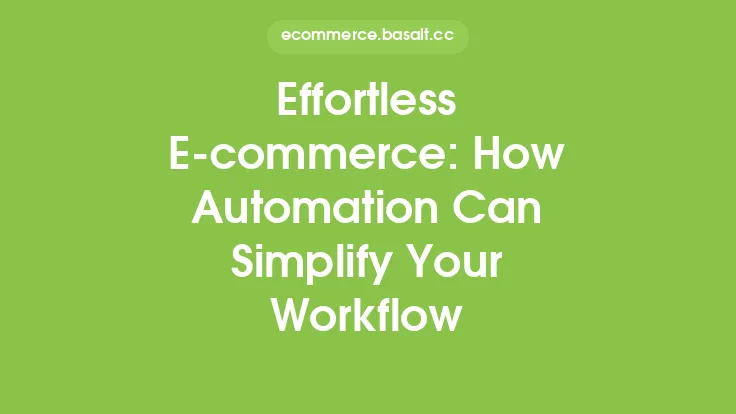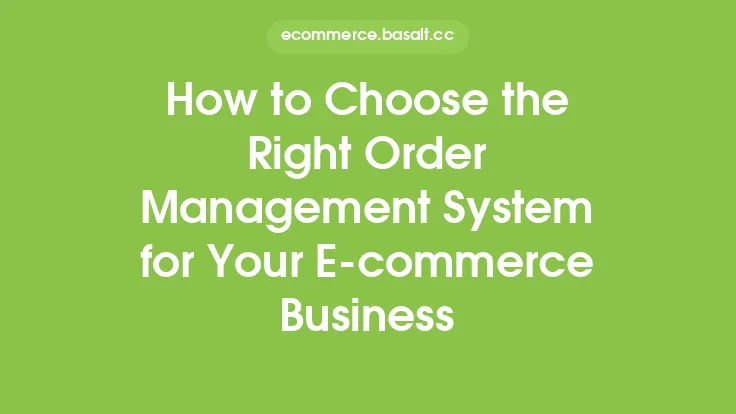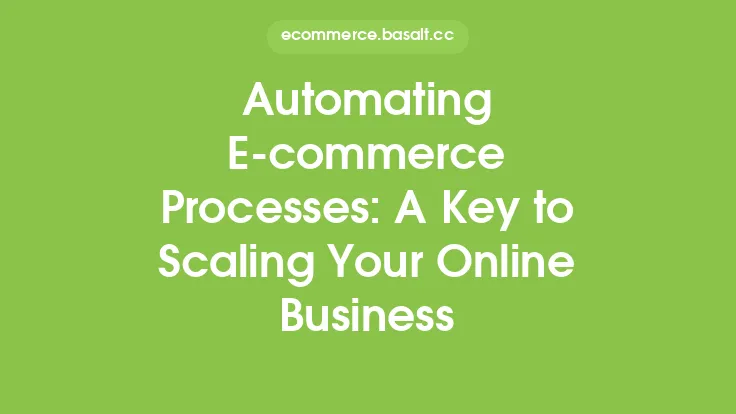Upgrading an e-commerce workflow from manual to automated is a crucial step for businesses looking to increase efficiency, reduce costs, and improve customer satisfaction. Manual workflows can be time-consuming, prone to errors, and often lead to bottlenecks, which can hinder the growth of an online business. Automation, on the other hand, can help streamline processes, freeing up resources and allowing businesses to focus on more strategic and creative tasks.
Understanding E-commerce Workflows
E-commerce workflows refer to the series of processes and tasks involved in managing an online store, from receiving and processing orders to shipping and handling customer inquiries. These workflows can be complex and involve multiple stakeholders, including suppliers, logistics providers, and customer service teams. Understanding the existing workflow is essential to identifying areas that can be automated and improved. This involves mapping out the current processes, identifying pain points, and determining the resources required to complete each task.
Identifying Automation Opportunities
To upgrade an e-commerce workflow from manual to automated, businesses need to identify areas that can be automated. This can include tasks such as order processing, inventory management, shipping and fulfillment, and customer service. Automation opportunities can be found in repetitive tasks, tasks that require a high degree of accuracy, and tasks that can be easily standardized. For example, automated order processing can help reduce errors and speed up the fulfillment process, while automated inventory management can help prevent stockouts and overstocking.
Choosing the Right Automation Tools
Once automation opportunities have been identified, businesses need to choose the right automation tools to implement. This can include software solutions such as workflow management systems, automation platforms, and integrations with existing e-commerce platforms. The choice of automation tool will depend on the specific needs of the business, the complexity of the workflow, and the resources available. It's essential to consider factors such as scalability, flexibility, and ease of use when selecting automation tools.
Implementing Automation Solutions
Implementing automation solutions requires careful planning and execution. This involves configuring the automation tools, integrating them with existing systems, and testing the automated workflows. It's essential to ensure that the automated workflows are aligned with the business's overall goals and objectives and that they meet the required standards of quality and accuracy. Businesses should also provide training to employees on the use of automation tools and ensure that they understand the benefits and limitations of automation.
Monitoring and Optimizing Automated Workflows
Once automation solutions have been implemented, businesses need to monitor and optimize the automated workflows to ensure they are running efficiently and effectively. This involves tracking key performance indicators (KPIs) such as processing times, error rates, and customer satisfaction. Businesses should also continuously review and refine the automated workflows to ensure they remain aligned with changing business needs and customer expectations. This can involve making adjustments to the automation tools, updating workflows, and adding new automation solutions as needed.
Overcoming Common Challenges
Upgrading an e-commerce workflow from manual to automated can be challenging, and businesses may encounter common obstacles such as resistance to change, technical difficulties, and integration issues. To overcome these challenges, businesses should communicate the benefits of automation to employees, provide training and support, and ensure that the automation tools are properly integrated with existing systems. It's also essential to have a clear understanding of the business's goals and objectives and to ensure that the automated workflows are aligned with these goals.
Best Practices for E-commerce Automation
To ensure successful e-commerce automation, businesses should follow best practices such as starting small, focusing on high-impact areas, and continuously monitoring and optimizing automated workflows. It's also essential to have a clear understanding of the business's workflows and to ensure that the automation tools are properly integrated with existing systems. Additionally, businesses should prioritize employee training and support, ensure that automated workflows are aligned with business goals, and continuously review and refine the automated workflows to ensure they remain effective and efficient.
Future of E-commerce Automation
The future of e-commerce automation is exciting, with emerging technologies such as artificial intelligence (AI), machine learning (ML), and the Internet of Things (IoT) expected to play a major role in shaping the industry. These technologies will enable businesses to automate more complex tasks, improve customer experiences, and gain deeper insights into customer behavior. As e-commerce automation continues to evolve, businesses will need to stay ahead of the curve, investing in the latest technologies and ensuring that their automated workflows remain aligned with changing customer expectations and business needs. By doing so, businesses can unlock new opportunities for growth, improve efficiency, and enhance customer satisfaction.




